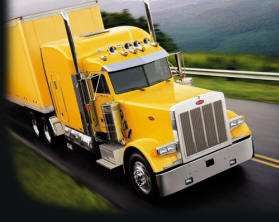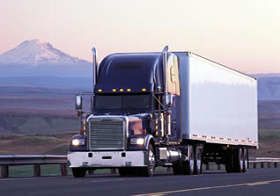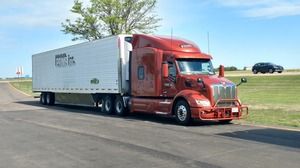Help ... I Suck At Backing
Topic 8013 | Page 1

So I just started my driving portion of the PSD program with prime and I'm having issues with backing and I'm not really comprehending what my instructor is telling me...any tips or suggestions welcome
Go slow. Less is more. If it doesn't feel right stop. Watch BOTH mirrors. Think of pushing a ball with your nose. The tail of the tractor is the nose and the trailer is the ball. When it's online it goes straight. If the tail wags right, the ball goes left. In the worst case, pull forward and straighten it out; do it again.
Go slow.
PSD:
Prime Student Driver
Prime Inc has a CDL training program and the first phase is referred to as PSD. You'll get your permit and then 10,000 miles of on the road instruction.
The following is from Prime's website:
Prime’s PSD begins with you obtaining your CDL permit. Then you’ll go on the road with a certified CDL instructor for no less than 75 hours of one-on-one behind the wheel training. After training, you’ll return to Prime’s corporate headquarters in Springfield, Missouri, for final CDL state testing and your CDL license.
Obtain CDL Permit / 4 Days
- Enter program, study and test for Missouri CDL permit.
- Start driving/training at Prime Training Center in Springfield, Missouri.
- Work toward 40,000 training dispatched miles (minimum) with food allowance while without CDL (Food allowance is paid back with future earnings).
On-the-Road Instruction / 10,000 Miles
- Train with experienced certified CDL instructor for 3-4 weeks in a real world environment.
- Get 75 hours of behind-the-wheel time with one-on-one student/instructor ratio.
- Earn 10,000 miles toward total 40,000 miles needed.

So I just started my driving portion of the PSD program with prime and I'm having issues with backing and I'm not really comprehending what my instructor is telling me...any tips or suggestions welcome
The best thing for backing is to tell your trainer to BUTT OUT and let you learn . . . I know this is real hard to do but I had a trainer and I've watched others at different times try to give you blow-by-blow instructions and all it ends up doing is confusing & frustrating the student . . . you GOTTA get a feel for what happens out THERE based on what you do in HERE, if you know what I mean . . . once someone tells you how to set up and then what to look for, you have GOT to try and fail . . . by fail I don't mean to hit something ... I mean to start backing, watching the trailer respond, getting out to look from every angle, getting back in the truck and doing it all over again . . . it's hard to describe, but once you get a feel for how quickly the trailer responds, you will start to see the "arc" the trailer takes and get a feel for how sharp to turn, how far back to go, when to do a pull up and how far up to go, etc. , but you need time WITHOUT SOMEONE TELLING YOU EVERY STEP what to do . . . you know yourself (as a student) that verbal instructions and hand waving do NO GOOD most of the time . . . get the basics in your head and TRY IT OUT ... how do you get your trainer to step back and watch (and make sure you don't hit anything)? Dunno ...that was the hardest part for me ... I finally told my instructor that he could do all the backing as all of his yelling and gyrations were not helping a BIT and I would wait until I got my own truck to really get it down ... I only did enough to pass the CDL exam and then taught myself the rest when I had room and time to practice ... lots of stares from other drivers but now I can put 'er right where she needs to be ...
Jopa




P.S. One thing my trainer did tell me that was golden is that you can tell a rookie by how he/she over corrects every little move ... that is so true, try to be SUBTLE and don't "crank" so hard on the wheel ...
CDL:
Commercial Driver's License (CDL)
A CDL is required to drive any of the following vehicles:
- Any combination of vehicles with a gross combined weight rating (GCWR) of 26,001 or more pounds, providing the gross vehicle weight rating (GVWR) of the vehicle being towed is in excess of 10,000 pounds.
- Any single vehicle with a GVWR of 26,001 or more pounds, or any such vehicle towing another not in excess of 10,000 pounds.
- Any vehicle, regardless of size, designed to transport 16 or more persons, including the driver.
- Any vehicle required by federal regulations to be placarded while transporting hazardous materials.
PSD:
Prime Student Driver
Prime Inc has a CDL training program and the first phase is referred to as PSD. You'll get your permit and then 10,000 miles of on the road instruction.
The following is from Prime's website:
Prime’s PSD begins with you obtaining your CDL permit. Then you’ll go on the road with a certified CDL instructor for no less than 75 hours of one-on-one behind the wheel training. After training, you’ll return to Prime’s corporate headquarters in Springfield, Missouri, for final CDL state testing and your CDL license.
Obtain CDL Permit / 4 Days
- Enter program, study and test for Missouri CDL permit.
- Start driving/training at Prime Training Center in Springfield, Missouri.
- Work toward 40,000 training dispatched miles (minimum) with food allowance while without CDL (Food allowance is paid back with future earnings).
On-the-Road Instruction / 10,000 Miles
- Train with experienced certified CDL instructor for 3-4 weeks in a real world environment.
- Get 75 hours of behind-the-wheel time with one-on-one student/instructor ratio.
- Earn 10,000 miles toward total 40,000 miles needed.

OH, one other tip that applies to more than backing: the farther back your tandems on the trailer, the more she cheats (they all cheat eventually, don't they?) By that I mean that the longer the wheel base under the trailer, the more it will move towards the side you are turning to ... on the road, this means watch the inside edge towards the curve in the road, if you going around a curve to the driver's side, the longer the wheel base (the tandems set to the back) the more the trailer takes a shorter arc than the tractor . . . the same is true as you are backing to the dock ... different "holes" make for different responses from the trailer ... keep this in mind so you don't get snake-bit (like hitting a parked car on a curve in down-town Washington D.C.) Who did that??
Jopa



Tandems:
Tandem Axles
A set of axles spaced close together, legally defined as more than 40 and less than 96 inches apart by the USDOT. Drivers tend to refer to the tandem axles on their trailer as just "tandems". You might hear a driver say, "I'm 400 pounds overweight on my tandems", referring to his trailer tandems, not his tractor tandems. Tractor tandems are generally just referred to as "drives" which is short for "drive axles".
Tandem:
Tandem Axles
A set of axles spaced close together, legally defined as more than 40 and less than 96 inches apart by the USDOT. Drivers tend to refer to the tandem axles on their trailer as just "tandems". You might hear a driver say, "I'm 400 pounds overweight on my tandems", referring to his trailer tandems, not his tractor tandems. Tractor tandems are generally just referred to as "drives" which is short for "drive axles".
My little suggestion is to remember that whatever you do with the steering wheel won't happen at the tandems for another 8-10 feet of travel. (You turn the wheel, start backing up, the tandems don't change direction until they've rolled 10 feet back.)
(Jopa actually said that, but he gets paid by the word.)
Tandems:
Tandem Axles
A set of axles spaced close together, legally defined as more than 40 and less than 96 inches apart by the USDOT. Drivers tend to refer to the tandem axles on their trailer as just "tandems". You might hear a driver say, "I'm 400 pounds overweight on my tandems", referring to his trailer tandems, not his tractor tandems. Tractor tandems are generally just referred to as "drives" which is short for "drive axles".
Tandem:
Tandem Axles
A set of axles spaced close together, legally defined as more than 40 and less than 96 inches apart by the USDOT. Drivers tend to refer to the tandem axles on their trailer as just "tandems". You might hear a driver say, "I'm 400 pounds overweight on my tandems", referring to his trailer tandems, not his tractor tandems. Tractor tandems are generally just referred to as "drives" which is short for "drive axles".

See if this helps. Pick up your driver side drive tire (rear axle of tractor) in your mirror. With your peripheral vision, draw a straight line to the rear trailer tire, if they are in unicent, you are rolling straight, if not, make the adjustment. All major corrections must be made outside the box, inside the box, you shouldn't have to move that wheel more than two inches. Don't forget to watch both mirrors like a ping pong match, back and forth, whatever side the trailer is swaying too, consider that the problem, turn the wheel towards the problem, get back to center with steering wheel, and the trailer will tuck in. If you need to tuck it in more, do that again. Most importantly, don't overthink it, when it clicks in your head, you will backing up to Boston.

Back when I started learning I had trouble setting up the trailer to back in. My trainer showed me how to set up the trailer and after I was able to get it in. At first I couldnt get it at all. But when I told my trainer I am having trouble setting it up to back it in and what do I look for to set up he told me and showed me while i was pulling up to where I need to go in 1st gear rolling SLOWLY . Once I got how to set it up before backing in. It all got easy NOW I can put that trailer anywhere I want.
Ty, almost everyone struggles with backing for at least their first six months. It's one of those things that you just have got to do over and over before you start getting the hang of it. Don't let it overly frustrate you, just realize it will come with repetition.
Setting up correctly is important and leaving yourself enough length of travel time to get the trailer started in the right direction is important. Ninety nine percent of rookie problems with backing are usually because of over-steering. It's difficult because usually your trainer is getting excited and barking out commands to turn it this way, no now that way, and it can be very confusing.
Hang in there, it will come, just not as quickly, or as easily as you would like.
HOS:
Hours Of Service
HOS refers to the logbook hours of service regulations.As Daniel K. said:
Pick up your driver side drive tire (rear axle of tractor) in your mirror. With your peripheral vision, draw a straight line to the rear trailer tire, if they are in unicent, you are rolling straight, if not, make the adjustment.
My trainer told me to line up the tires with the yellow dock lines, and to visualize the yellow dock lines as continuing on straight out, to give me something to aim for. However, when I am backing up, and looking in mirrors, that is not enough. So I went to the Dollar Store and bought a yellow rubber sink mat, and cut it into half to make two strips. I lay those down to extend the yellow lines (which are sometimes faint anyway), and then I have something to aim for.
Sometimes I get out and stand in the dock spot and look towards my truck. I picture how it needs to turn, and the arc it needs to follow. I also bought four orange mini-cones at WalMart that I set out along the line of that imaginary arc, to guide me in. Sometimes one is enough, just to show a pivot point. I may be the "dorky rookie driver", but it's better than spending an hour trying to back into a spot. Oh, but those little orange cones don't stay put if it's icy and windy!
And as Old School said
Setting up correctly is important and leaving yourself enough length of travel time to get the trailer started in the right direction is important.
My trainer told me "if you've got the space, USE IT". Very good advice. Some days I can back it right in, other days . . . not so much. I've found that if I try to go too fast, or worry about the folks waiting and watching me, that's when I screw up the worst. It's best to just pretend I'm there all by myself.
HOS:
Hours Of Service
HOS refers to the logbook hours of service regulations.
One thing that I have always done is to put my hand onto the bottom of the steering wheel, then move my hand in the direction that I want/need the trailer to go in. Example, need the trailer to go left, move your hand left and you will find that you are turning the wheel opposite of the direction you would think. Works every time.
Also, as has been said before, don't turn the wheel any more than needed. Let the trailer start turning before trying to make any corrections because it does take a few seconds for it to respond the last correction/turn.
Hope this helps some.
Ernie
New Reply:
New! Check out our help videos for a better understanding of our forum features

















Preview:
This topic has the following tags:
Prime Inc Swift Transport Advice For New Truck Drivers Tips For Backing







 TT On Facebook
TT On Facebook
So I just started my driving portion of the PSD program with prime and I'm having issues with backing and I'm not really comprehending what my instructor is telling me...any tips or suggestions welcome
PSD:
Prime Student Driver
Prime Inc has a CDL training program and the first phase is referred to as PSD. You'll get your permit and then 10,000 miles of on the road instruction.
The following is from Prime's website:
Prime’s PSD begins with you obtaining your CDL permit. Then you’ll go on the road with a certified CDL instructor for no less than 75 hours of one-on-one behind the wheel training. After training, you’ll return to Prime’s corporate headquarters in Springfield, Missouri, for final CDL state testing and your CDL license.
Obtain CDL Permit / 4 Days
On-the-Road Instruction / 10,000 Miles